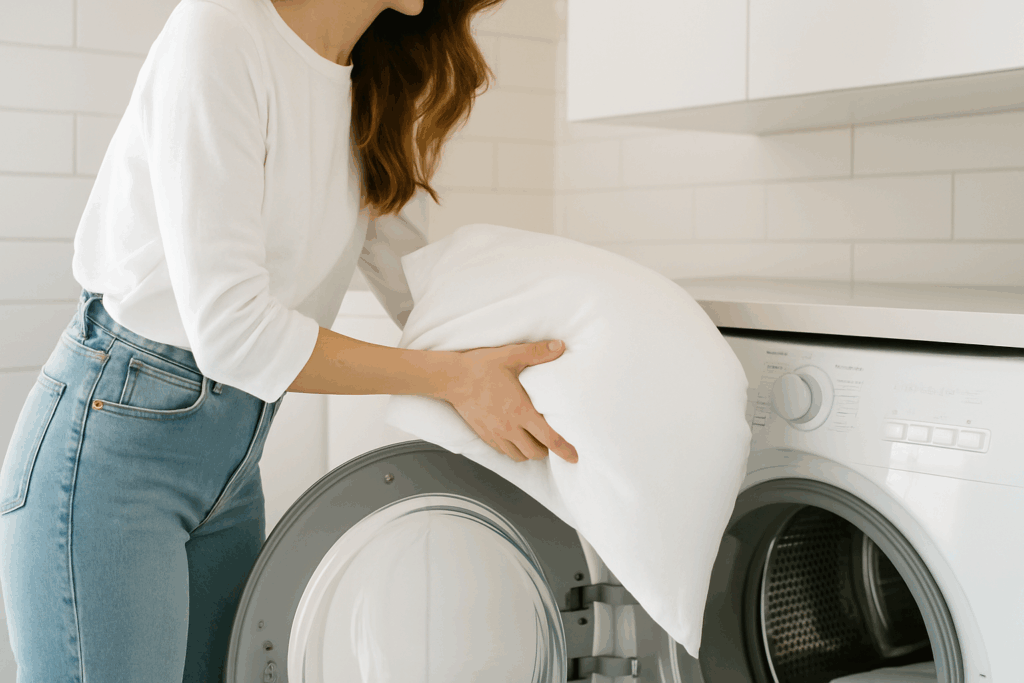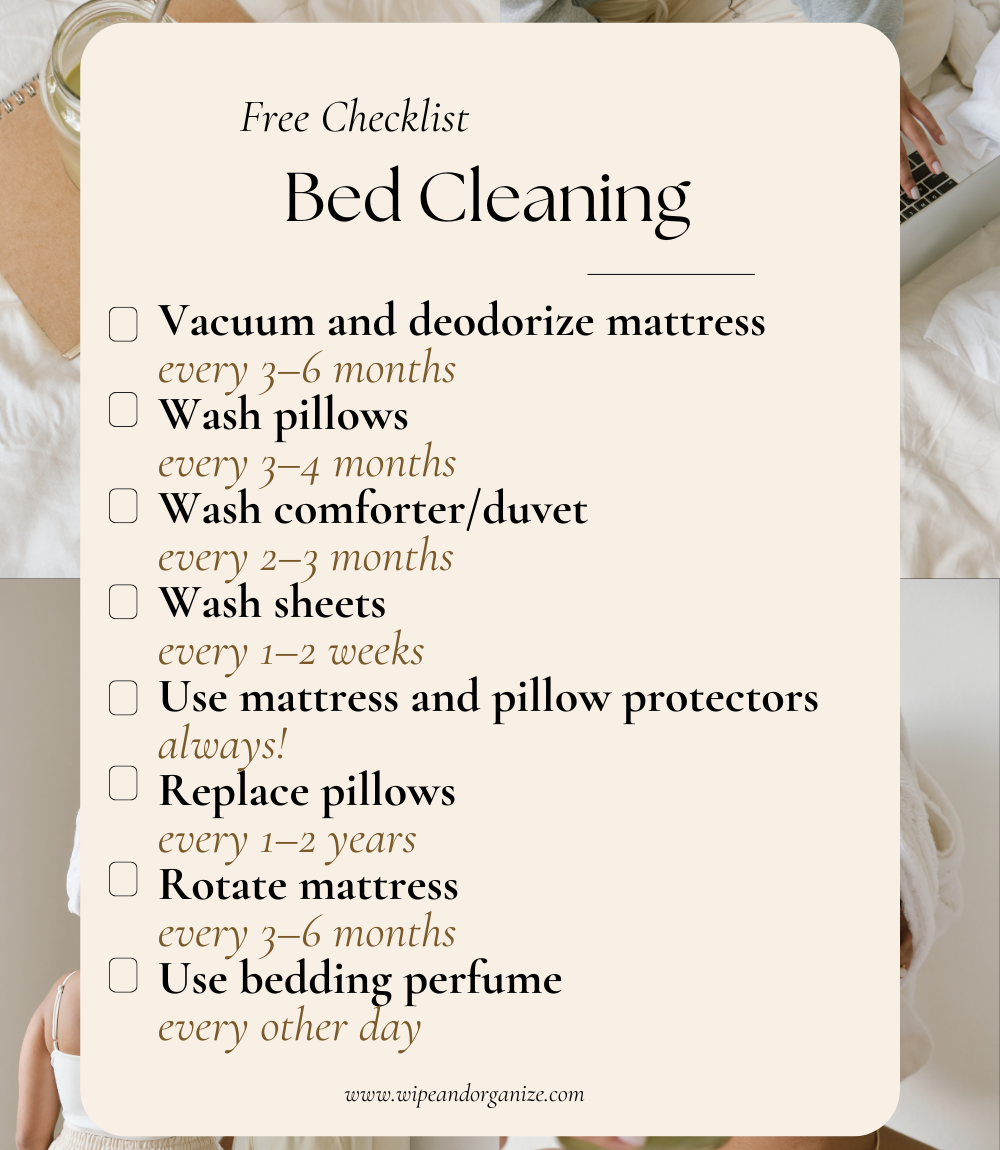If there’s one thing I’ve learned as a cleaning lady and mom of two very active teens, it’s that bedding can get gross fast. Between night sweats, snacks in bed, and the occasional spill, our mattresses, pillows, duvets, and sheets take a real beating. And while most of us are pretty good at tossing sheets in the laundry, the rest? Gets ignored until we can’t anymore.
The good news? With the right routine, tools, and a little know-how, you can keep your bedding fresh, clean, and long-lasting — without turning it into a weekend project. In this guide, I’m walking you through how to care for each part of your bed setup, with product recommendations I personally love and a checklist you can print and keep on your laundry room wall.

Why Bedding Care Matters
We spend roughly one-third of our lives in bed. According to the Sleep Foundation, that’s around 26 years spent sleeping. And yet, most people don’t wash their pillows or deep clean their mattresses for years.
Over time, bedding absorbs:
- Body oils and sweat
- Dead skin cells
- Dust mites and allergens
- Bacteria and even mold (yikes!)
Neglecting to clean these regularly can lead to allergies, skin irritation, bad smells, and shorter product lifespan. So let’s break it down step by step.
🛏️ 1. How to Clean & Protect Your Mattress
Frequency: Deep clean every 3–6 months
Steps:
- Strip the bed and vacuum the entire mattress (use the upholstery attachment).
- Sprinkle baking soda over the surface and let it sit for 20–30 minutes to deodorize.
- Vacuum again thoroughly.
- Spot clean stains with a 1:1 mix of water and white vinegar or use an enzyme cleaner.
- Allow the mattress to air dry completely before making the bed.
Protect it:
- Use a waterproof mattress protector to keep moisture, dust, and allergens away.
- Rotate your mattress every 3–6 months for even wear.
⭐ Recommended Product: SafeRest Premium Mattress Protector
Waterproof, hypoallergenic, and quiet — this protector keeps your mattress safe without making it feel plasticky.

🛌 2. How to Wash Pillows
Frequency: Every 3–4 months
Steps:
- Check the label — most synthetic or down pillows are machine washable.
- Wash 2 pillows at a time for balance.
- Use a mild detergent, and select a gentle cycle with warm water.
- Dry thoroughly on low heat. Add dryer balls or clean tennis balls to fluff.
Tip: If your pillow smells musty or feels flat, it might be time to replace it.
⭐ Recommended Product: Beckham Hotel Collection Gel Pillows
Machine-washable, super plush, and cooling — these pillows are a fan favorite with over 100,000 reviews.
💌 3. How to Care for Duvets & Comforters
Frequency: Every 2–3 months
Steps:
- Check the care label. Many comforters are machine washable, but some need professional cleaning.
- Use a large-capacity washer and a gentle detergent.
- Wash on a delicate cycle with cold water.
- Dry thoroughly on low heat with dryer balls to prevent clumping.
Tip: Use a duvet cover — it’s easier to wash regularly than the whole insert.
⭐ Recommended Product: Utopia Bedding Comforter Duvet Insert
Lightweight, machine-washable, and budget-friendly. Great for all-season use and easy to pair with covers.
🧺 4. Washing Bed Sheets the Right Way
Frequency: Every 1–2 weeks
Steps:
- Wash sheets in warm water with a gentle detergent.
- Avoid fabric softeners (they reduce absorbency and may irritate skin).
- Dry on medium heat or hang in sunlight when possible (sun is a natural sanitizer!).
Quick Stats: A study by the National Sleep Foundation found that 91% of people say clean sheets help them sleep better.
⭐ Recommended Product: Hotel Bedding 100% Cotton Sheets
Breathable, long-lasting, and OEKO-TEX certified for safety — perfect for everyday comfort.
🧹 Bedding Care Checklist
Print this out or pin it on your laundry room door:

Final Thoughts from a Bedding-Obsessed Mom
In a busy household like mine, it’s easy to let deep cleaning tasks slip to the bottom of the list. But caring for your bedding doesn’t have to be overwhelming. Set a reminder on your phone or build these tasks into your seasonal cleaning schedule.
Your bed should be a sanctuary — not a breeding ground for allergens or bad smells. So grab some vinegar, fluff those pillows, and treat your mattress like the MVP it is.
Trust me: you’ll feel the difference every night.

















One Response
Our bed and bedding is abused and has been disgusting where I’ve slept on couch . the cats lay with us in bed sweatying food and drinks have been spilled on sheets then we move might not talk about it but we know sex secreations and my wifes a squirter also so yea icky . Whats the best cleaning product for best results? I’m sure most have dealt with type of nasty ? How & what worked best for you ?